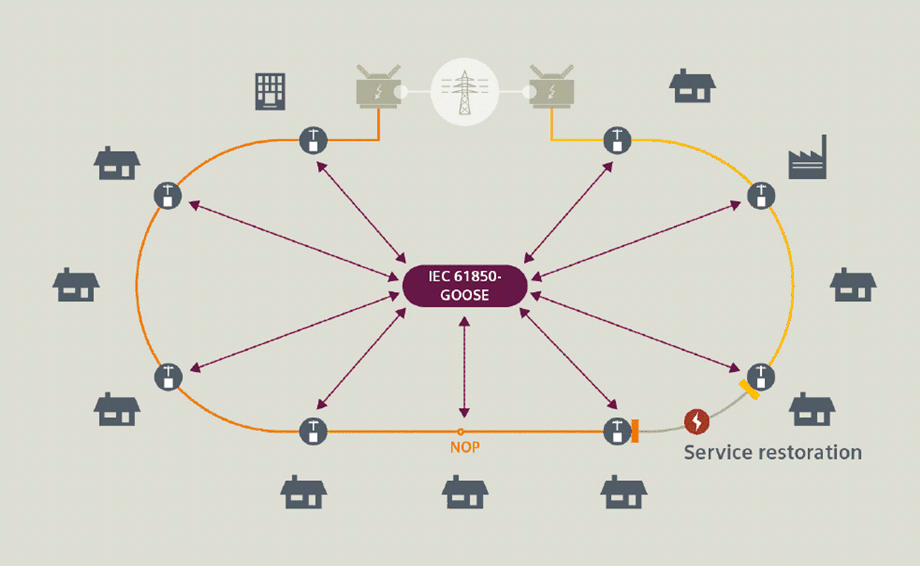Content for TS 22.104 Word version: 19.2.0
0f…
4…
5…
5.3…
6…
A…
A.2.2…
A.2.2.4…
A.2.3…
A.4…
A.4.4…
A.4.4.3…
A.4.5…
A.4.8…
A.5…
A.6…
B…
C…
C.3
C.4…
C.5
D…
E…
A.4.4 Distributed energy automation
A.4.4.1 Distributed automated switching for isolation and service restoration
A.4.4.2 Distributed automation without GOOSE
...
...
A.4.4 Distributed energy automation p. 57
A.4.4.1 Distributed automated switching for isolation and service restoration |R18| p. 57
A power distribution grid fault is a stressful situation. There are self-healing solutions for automated switching, fault isolation, and service restoration. Furthermore, these solutions are ideally suited to handle outages that affect critical power consumers, such as industrial plants or data centres. Supply interruptions must be fixed within less than a second for critical power consumers. Automated solutions are able to restore power supply within a few hundred milliseconds.

Figure A.4.4.1-1: Depiction of a distribution ring and a failure (flash of lighting)
(⇒ copy of original 3GPP image)
(⇒ copy of original 3GPP image)
The FLISR (Fault Location, Isolation & Service Restoration) solution consists of switch controller devices which are especially designed for feeder automation applications that support the self-healing of power distribution grids with overhead lines. They serve as control units for reclosers and disconnectors in overhead line distribution grids.
The system is designed for using fully distributed, independent automated devices. The logic resides in each individual feeder automation controller located at the poles in the feeder level. Each feeder section has a controller device. Using peer-to-peer communication among the controller devices, the system operates autonomously without the need of a regional controller or control centre. However, all self-healing steps carried out will be reported immediately to the control centre to keep the grid status up to date. The controllers conduct self-healing of the distribution line in typically 500 ms by isolating the faults.
Peer-to-peer communication via IEC 61850 GOOSE (Generic Object Oriented Substation Event) messages provides data as fast as possible (Layer 2 multicast message). They are sent periodically (in steady state, with changing interval time in fault case) by each controller to several or all other controllers of the same feeder and are not acknowledged.
The service bit rate per controller is low in steady state, but GOOSE bursts with high service bit rate do occur, especially during fault situations. GOOSE messages are sent by several or all controller units of the feeder nearly at the same point in time during the fault location, isolation and service restoration procedure with a low end-to-end latency.
The associated (a)periodic communication KPIs are provided in Table A.4.4.1-1.
| Use case # | Characteristic parameter | Influence quantity | ||||||||
|---|---|---|---|---|---|---|---|---|---|---|
| Communication service availability: target value [%] | Communication service reliability: mean time between failures | End-to-end latency: maximum | Service bitrate: user experienced data rate | Message size [byte] | Transfer interval: target value | Survival time | UE speed | # of UEs | Service area (note 1) | |
| 1 (note 2) | 99.999 9 | – | < 5 ms | 1 kbit/s (steady state) 1.5 Mbit/s (fault case) | < 1,500 | < 60 s (steady state) ≥ 1 ms (fault case) | transfer interval (one frame loss) | stationary | 20 | 30 km x 20 km |
| 2 | > 99.999 % | - | 20 ms (note 2) | - | < 100 | - | - | stationary | ≤ 100/km² | several km² |
|
NOTE 1:
Length x width
NOTE 2:
UE to UE communication (two wireless links)
|
||||||||||
Use case one
GOOSE (a)periodic deterministic communication service supporting bursty message exchange for fault location, isolation, and service restoration.
Use case two
Typically event-driven, aperiodic deterministic communication service supporting fault detection and isolation.
A.4.4.2 Distributed automation without GOOSE |R18| p. 59
If the control of electrical power distribution components is performed from a central system entity, the controlled entities can be operated in a way that a controlled service restoration is possible without the use of GOOSE. Though this is not as effective as the communication has less strict requirements, this form of distribution automation is nevertheless effective, and it is also compliant with IEC standards and widely deployed in energy systems. The associated KPI is provided in Table A.4.4.2-1.
| Use case # | Characteristic parameter | Influence quantity | ||||||||
|---|---|---|---|---|---|---|---|---|---|---|
| Communication service availability: target value [%] | Communication service reliability: mean time between failures | End-to-end latency: maximum | Service bitrate: user experienced data rate | Message size [byte] | Transfer interval: target value | Survival time | UE speed | # of UEs | Service area | |
| 1 | 99.999 | – | 100 ms to 2 s | 9.6 to 100 | – | – | – | – | Concentrated rural: 70.8; Dispersed rural and semi-urban: 7.6; rural support: 0.048; urban: 11.0 | several km² |
Use case one
Distributed automation without use of GOOSE using a centralized architecture.